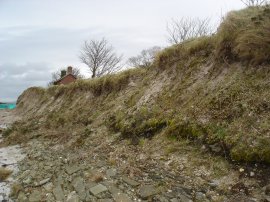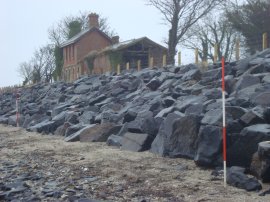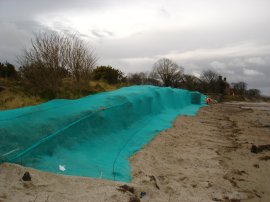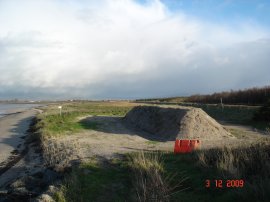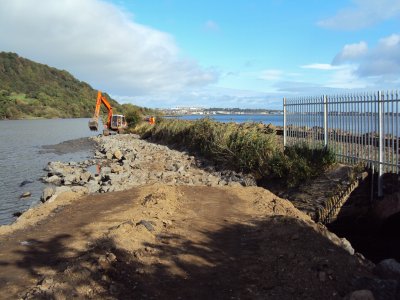Remedial works to NIR Sea Defences:Whitehead to Larne and Coleraine to Londonderry |
|
Whole Project Award
Project Team:
Client: Translink - Northern Ireland Railways
Designer: URS / Scott Wilson
Contractor: McLaughlin and Harvey Ltd
The project
The project comprised of essential repairs and upgrading to existing sea defences at various locations along the Derry to Coleraine railway line and also the Whitehead to Larne railway line along the Antrim coast in Northern Ireland.
The works included infilling of salient voids in existing revetments, infilling cracks in sea walls, placing stone to prevent undercutting at the toe of revetments and the installation of major rock armour structures at two locations. Through the course of the works approximately 25,000 tonnes of rock armour were replaced and installed. As part of the detailed design an analysis of the force generated by waves was used to determine the size, quantity and quality of armour installed. Although there were many sections of work, one of the major sites was at Carrickhugh on the Coleraine to Derry railway line. At this location a coarse grained sand embankment was being continually eroded back towards the railway line. Ugent works were necessary in order to protect the line against undermining by installing a robust rock armour structure.
Carrickhugh - existing sand embankment |
Carrickhugh - after rock armour placement |
Planning
The planned refurbishment works lay on the boundary of three Natura 2000 sites, Larne Lough Special Protection Area (SPA), Magilligan Special Area of Conservation (SAC), Bann Estuary SAC and Lough Foyle SPA. Under Article 6(3) and (4) of the Habitats Directive (92/43/EEC) and The Conservation (Natural Habitats, etc) Regulations (Northern Ireland) 1995 (as amended), it was necessary to assess the implications of the planned works in view of the sites' conservation objectives. In addition as Scott Wilson would be representing Northern Ireland Railways, a competent Authority, it was necessary to consult with the Northern Ireland Environment Agency (NIEA) under the same regulations. As a result, NIEA were consulted immediately and a Habitat Regulations Assessment was carried out for each site. The SPA sites were designated for their important breeding and wintering bird populations including Roseate and Common Terns, wintering Brent Geese, Whooper Swans and Bar-Tailed Godwit. The Lough Foyle SPA site also qualifies under Article 4.2 of the Birds Directive by supporting over 20,000 migratory waterfowl. The SAC site is designated for its range of sand dune habitats. The results of each assessment concluded at Stage 1 Screening and found that the planned works would not adversely affect any of the selection features of the designated sites.
Each of the Natura 2000 sites were also nationally designated as Areas of Special Scientific Interest (ASSI). To comply with the Environment Order 2000, it was necessary to provide an Assent Notification to NIEA to confirm the work was not causing adverse effects to the interest features of the ASSI.
Finally, as the planned works would be placing material below the High Water Marks (HWMs) tidemark it was necessary to apply for a Food and Environment Protection (FEPA) Licence under Part II of the Food and Environment Protection Act, 1985 to control deposit of articles in the sea. In Northern Ireland, the Department of Environment (DOE) is responsible for this Act and NIEA facilitate the licensing process. A FEPA licence was submitted along with an accompanying Habitat Regulations Assessment.
Consideration of the environment
At Carrickhugh the sand embankment, which was to be replaced with rock armour as part of the strengthening works, provided natural habitat to a colony of approximately 80 Sandmartins. Therefore as part of the mitigation strategy, netting was positioned over the existing embankment prior to the nesting season to prevent Sandmartins from roosting at this location. This allowed construction to commence when required without any conflict with live nests.
However to encourage the continued presence of Sandmartins at this location after the works were completed an alternative nesting site was established. This was constructed close by from material removed from the existing embankment during the preparation works to install the rock armour structure.
|
|
To minimise the consumption of mains water, a sump hole was created at each site to collect tidal sea water and this was used to wash the newly placed rock armour. At the Glynn site, there was an existing stream and therefore to minimise degradation a small access bridge was constructed to allow plant access to the site.
Temporary access across Watercourse
|
The carbon footprint of the scheme was reduced by using the rail network to transport much of the rock armour to the various sites. A Road Rail Excavator was then used to position the rock appropriately.


